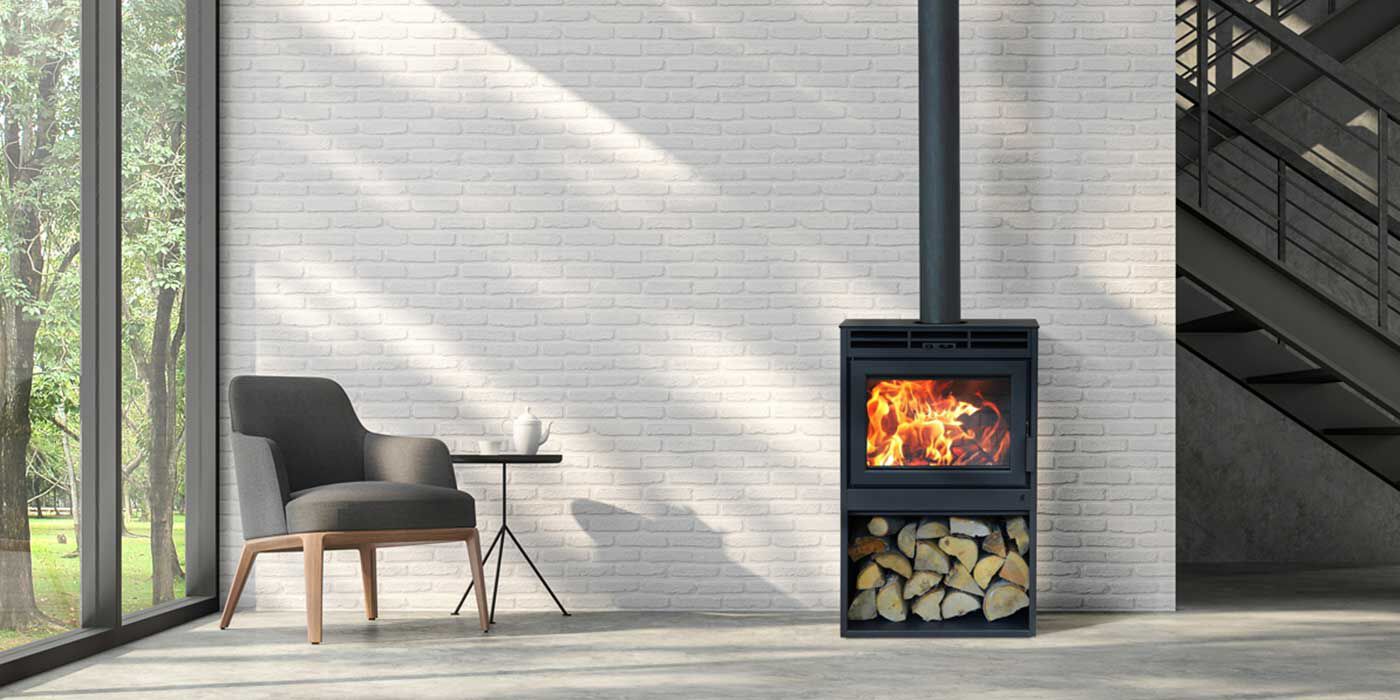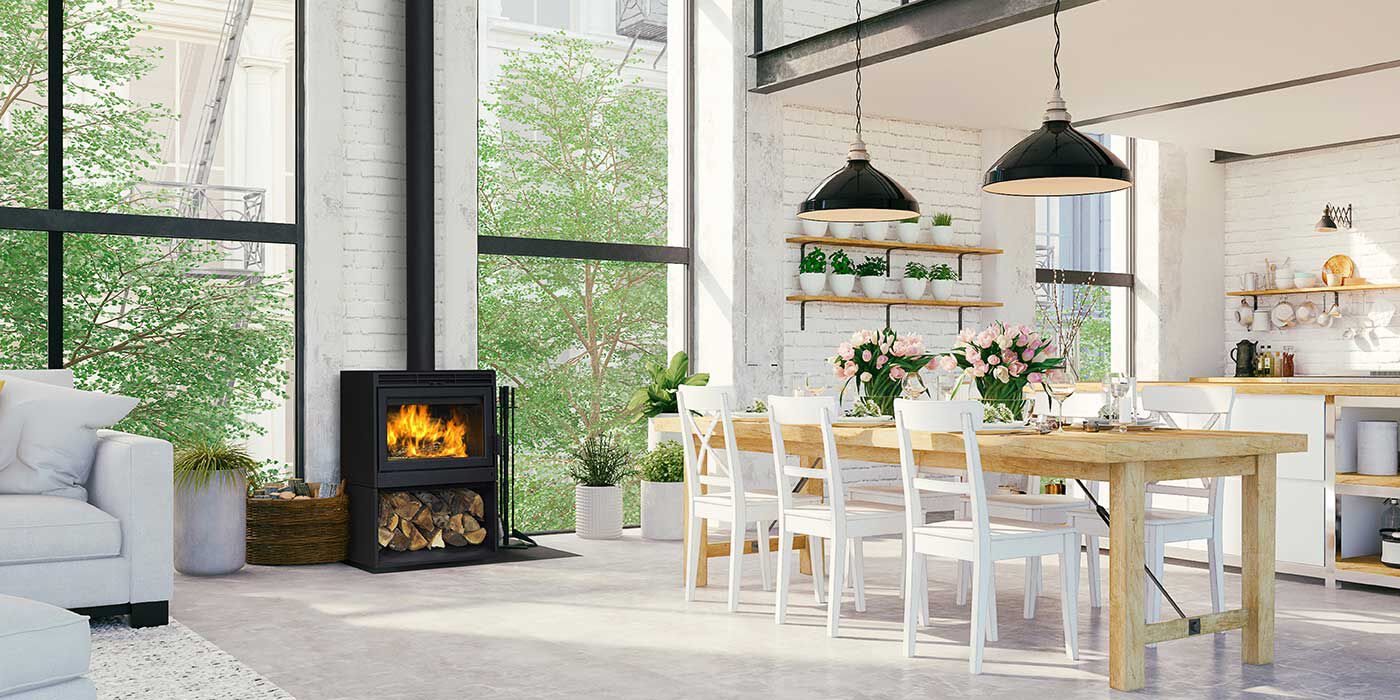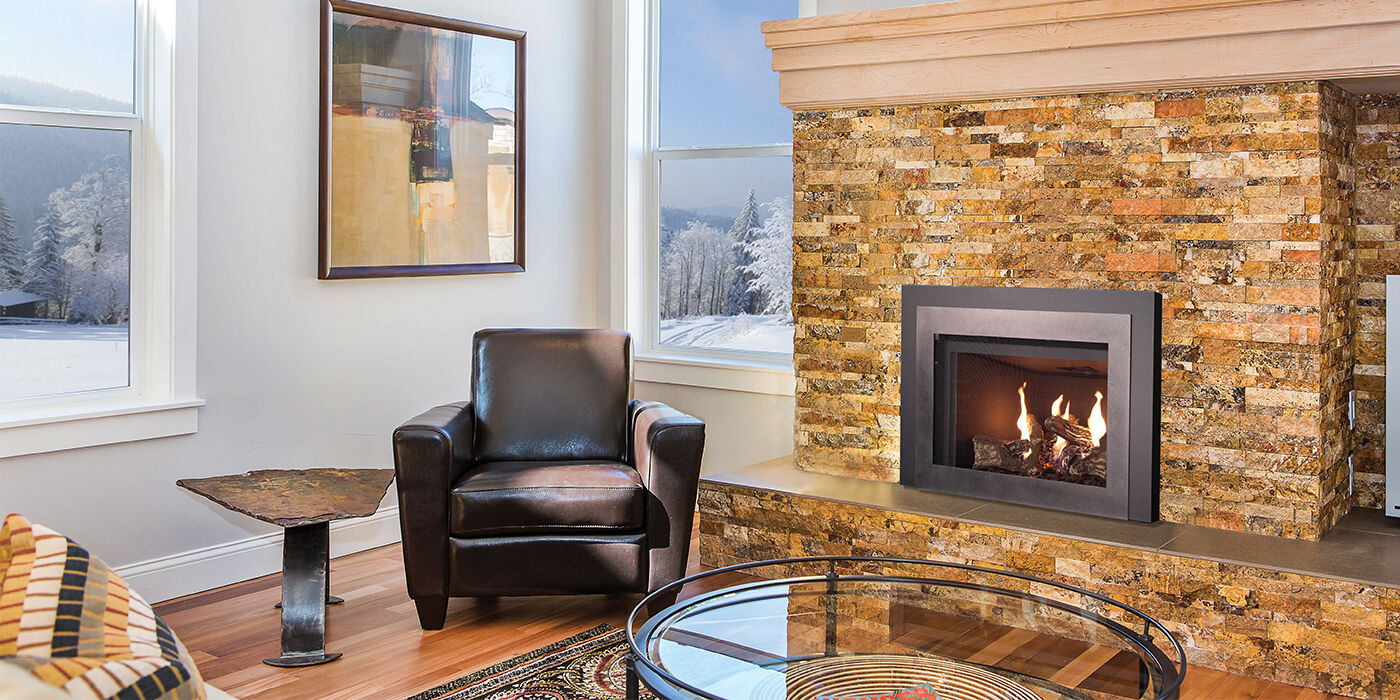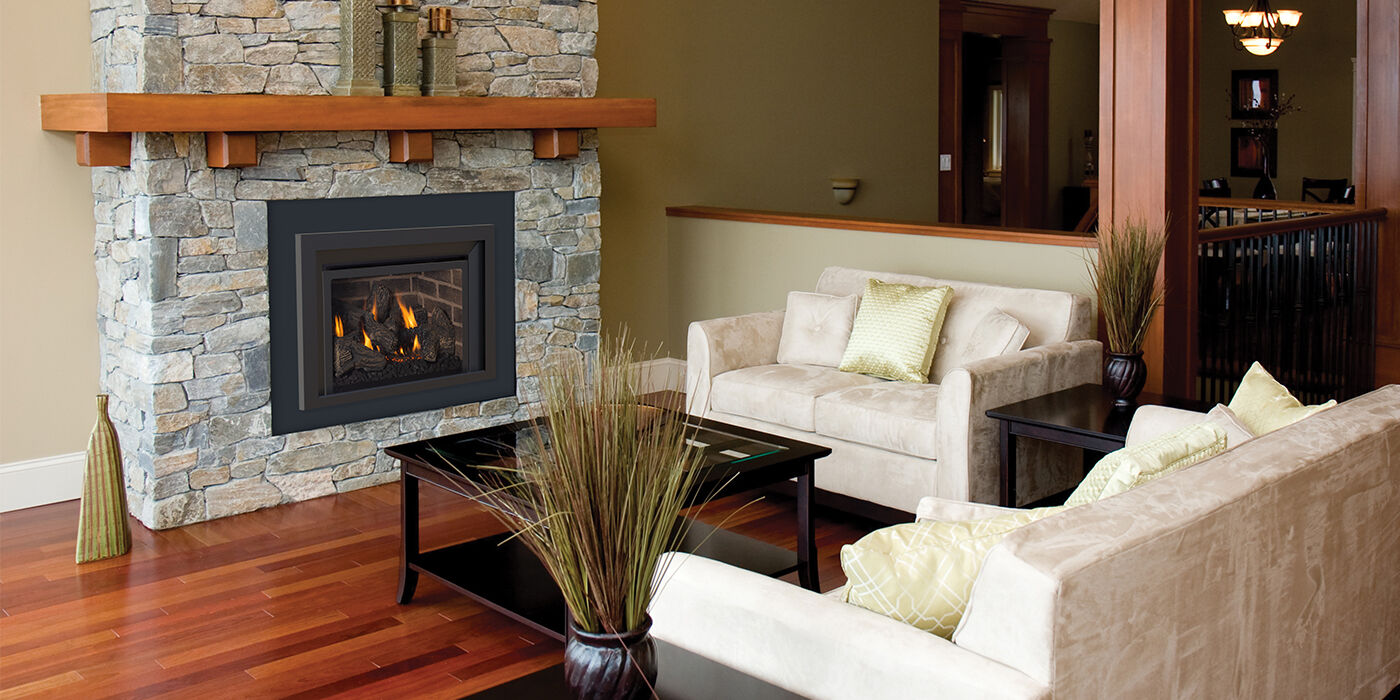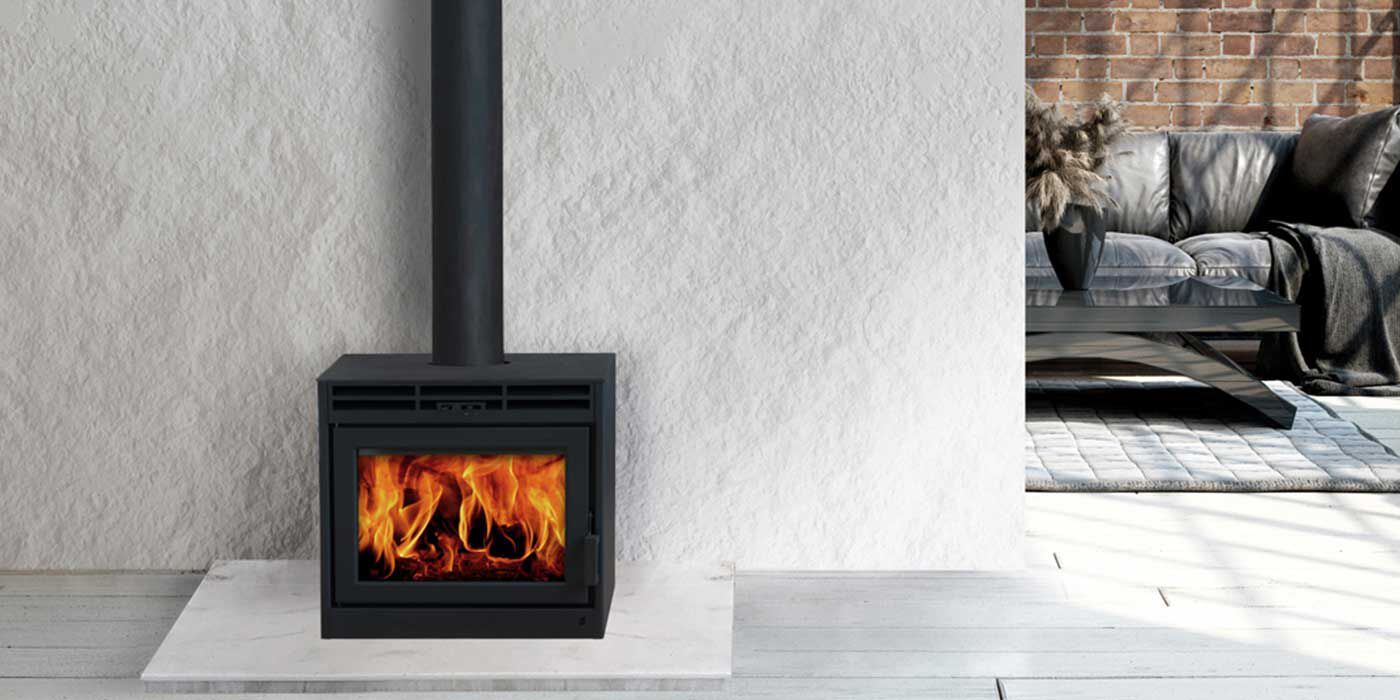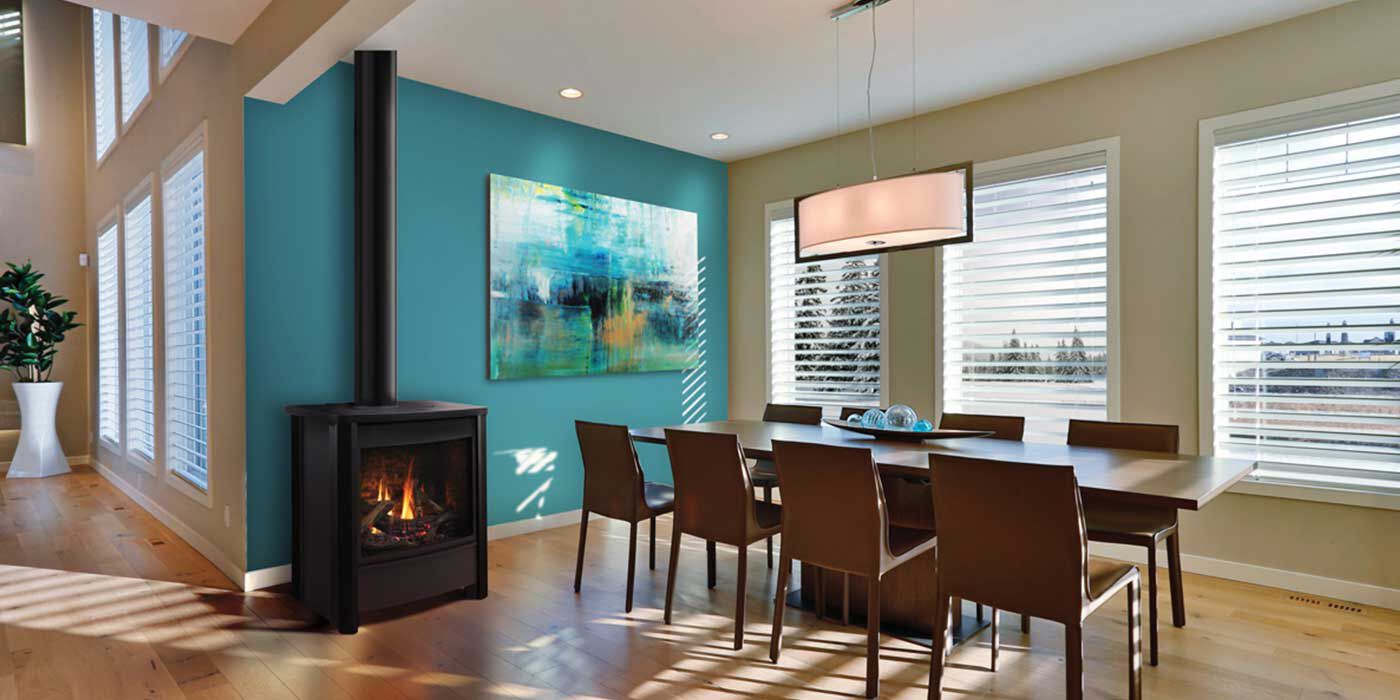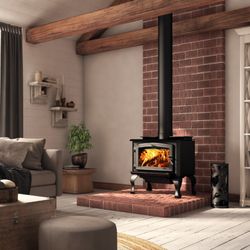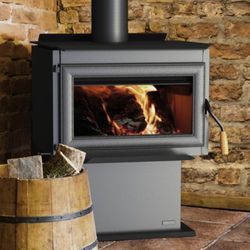By: Tiffany Kurilla, NFI Certified Master Hearth Professional
Last Updated: May 7, 2025
Wood burning stoves are a popular, eco-friendly, and efficient heating solution. Plus, the soothing crackle and inviting warmth of authentic flames adds a touch of rustic charm to your home.
Finding the right wood stove for your space can be a challenge, as there are many designs to choose from, each offering distinct features and benefits.
We’ve compiled the key factors to consider as you shop for your new wood burning stove, so you can confidently choose a model that suits your space and lifestyle.
How Does a Wood Stove Work?
Similar to wood burning fireplaces, wood stoves have a firebox, door, damper, and flue.
The firebox serves as a combustion chamber for burning wood, while the door is used for loading logs into the stove.
The damper regulates airflow, ensuring your fire burns efficiently, and the flue removes smoke from the stove, venting it outside of your home.
Wood burning stoves use seasoned logs as fuel. Once you place your logs inside the firebox, you can start the fire using kindling or fire starters.
One of the best things about wood stoves is they create incredible radiant heat. When lit, they quickly absorb and hold onto heat, then direct it back into your home.
Some stoves also use convection heating, where cool air is drawn into the firebox, heated, and expelled back into the room.
Benefits of Buying a Wood Stove
In addition to increasing the value of your property, wood stoves provide a few notable advantages, including:
Constant Warmth – Wood stoves are very efficient heat source. They can generate a significant amount of warmth from a relatively small amount of wood. They also continue to produce heat in the event of a power outage, which is important if you live in an area with inclement weather conditions.
Energy Efficiency – Installing a wood stove in a central living room reduces your reliance on gas and electricity, helping you save on utility costs during the winter months.
Eco-friendly Home Heating – Seasoned wood is a renewable and carbon-neutral energy source. Modern wood stoves also incorporate advanced combustion technologies to ensure minimal pollutants are released into the air during the burning process.
Cooking and Heating Water – Some wood stoves are designed to cook food and heat water. Many homeowners like the added functionality beyond space heating.
Pro Tip:
The environmental impact of your wood stove can vary depending on the type of wood you use, your stove’s efficiency rating, and the presence of other pollutants in the area. It is essential to research your city’s local regulations regarding wood stoves to ensure the model you choose complies.
Size & Capacity
Before purchasing a new stove, you'll need to determine what size and heating capacity will best suit your space. Smaller stoves are perfect for cabins or single rooms, while larger stoves can cover more square feet.
Typically, a small wood stove will heat less than 500 sq. ft. of space, a medium stove will heat between 500-1,000 sq. ft., and a large model can heat up to 2,200 sq. ft.
If you purchase a stove that’s too large for your space and decide to use less wood than it requires, it may not burn the wood completely, leading to an inefficient use of fuel and creating more pollutants.
If you overload a stove that’s too small to warm your space with the appropriate amount of wood, it could overheat and increase the risk of a chimney fire.
You'll need to determine the square footage of the area you’d like to install your wood stove in, so you can select a model with the appropriate BTU (British Thermal Units) output.
There are a several factors that can influence the heating capacity of your wood stove, including:
Your Ceiling Height – The heating capacity of your wood stove could drastically change based on the total volume of the room.
Your Home’s Insulation – Older homes with poor insulation may decrease the heating capacity of your stove, while newly built, highly insulated homes can significantly increase the heating capacity.
Windows & Walls in Your Home – Your stove’s heating capacity may fluctuate if you have windows that leak cool air into your home. Large, open spaces with a lot of walls can be tricky to heat as well.
The Type of Wood You Burn – Some types of wood burn more efficiently than others due to their dense, naturally dry compositions. These logs radiate intense heat over a long period of time, boosting the heating capacity of your wood stove.
Pro Tip:
You should only burn seasoned wood in your stove — logs that have been properly dried out. Burning freshly cut firewood is unsafe and inefficient because it has a high moisture content. “Green” wood produces excess smoke and causes creosote and soot buildup. Eventually, this creates a huge fire hazard in your space.
Efficiency Rating
A wood stove's efficiency is measured by the amount of heat generated per wood fuel unit. Models with a higher efficiency rating require less wood, reducing your fuel costs and environmental impact.
The Environmental Protection Agency (EPA) regulates the emissions of wood stoves, ensuring that they meet strict standards for safety and air quality.
The safest and most efficient wood stoves have an EPA certification, meaning they’ve been tested to burn better and cleaner than non-certified models.
Catalytic vs Non-Catalytic
Wood burning stoves come in two main types, catalytic and non-catalytic.
A catalytic wood burning stove equipped with a catalytic combustor that assists in the combustion process, reducing the amount of smoke produced.
Catalytic stoves achieve higher combustion temperatures and extract more heat from the wood, resulting in higher heat output and longer burn times. This increased efficiency leads to lower wood consumption and reduced emissions.
On the other hand, non-catalytic wood stoves use a secondary combustion system that burns off gases before escaping the stove.
While non-catalytic stoves offer less heat than catalytic models, they are easier to operate and maintain.
Wood Stove Styles & Materials
Wood stoves come in a wide variety of designs and styles, ranging from traditional to contemporary. They’re also available in a few different durable materials, including cast iron, steel, and soapstone.
Cast iron stoves are sturdy and retain heat for a long time, while steel and soapstone stoves are lighter and easier to relocate.
Even though steel stoves won’t radiate as much warmth as cast iron models, they heat up quickly and take less time to cool down once the fire is put out.
Cast iron stoves require periodic maintenance to prevent rust, such as re-seasoning and paint touch-ups. Steel models are prone to rusting and must be cleaned frequently, while soapstone wood stoves resist rust and only require occasional cleaning and re-sealing.
Freestanding Wood Stoves
Freestanding wood stoves are standalone units that require a non-combustible hearth and a dedicated chimney or stovepipe for venting.
Typically installed in the center of your main living space, freestanding models radiate heat evenly in all directions.
Our Best-Selling Freestanding Stoves
Wood Stove Inserts
Wood stove inserts are designed to fit inside existing masonry or prefabricated fireplaces. They are installed within the fireplace opening, converting it to a wood burning stove.
These units are equipped with front-facing doors and blower systems to help circulate heat throughout your home. They also require an existing chimney for proper ventilation.
Our Best-Selling Wood Stove Inserts
Installation Process
Wood stove installation requires technical expertise, so you’ll need to hire a professional to handle the project.
A local hearth professional or contractor will already be up to date on your area’s specific codes and regulations regarding wood burning stoves. They’ll also be able to determine the safest location for your stove and the best venting option.
To use your wood stove safely, it must be installed on a secure, non-combustible platform that can support its weight. The type and size of the platform will depend on your local codes.
Your wood stove should be placed a safe distance from the wall and any combustible materials. It also must be installed in an area that won’t obstruct the flue to ensure sufficient ventilation.
Clearance requirements will vary, depending on the model you purchase. Before you choose a final location for your wood stove, be sure to read the installation guidelines outlined in the manual.
For extra peace of mind, make sure you mount a smoke detector and a carbon monoxide detector near your wood burning stove.
Wood Stove Accessories
There are a few accessories available to enhance the performance, safety, and convenience of your wood burning stove, including:
Firewood Rack – A firewood rack will keep your seasoned logs organized, dry, and easily accessible
Log Carrier – Easily transport firewood inside your home with a leather or canvas log carrier
Tools – A poker, a pair of tongs, a brush, and an ash shovel allow you to stoke the flames, adjust the logs, and clean out your wood stove with ease
Heavy-Duty Gloves – Safely handle sharp logs or hot tools with a pair of thick, heat-resistant gloves
Fireplace Grate – A grate elevates the logs from the bottom of your stove, allowing air to circulate underneath the logs to improve combustion and reduce smoke. Not all wood stoves require a grate, so be sure to check your installation manual before purchasing one.
People Also Ask
Do I need a chimney for a wood stove?
Yes, a wood stove needs a properly installed chimney or flue system to vent smoke and combustion gases safely outside the home.
How often should I clean my wood stove and chimney?
Clean the stove’s firebox and ash pan weekly (if used regularly), and have the chimney professionally inspected and cleaned at least once a year.
Is it safe to leave a wood burning stove on overnight?
It can be safe with a properly installed and operated stove. Always follow the manufacturer’s instructions, use dry hardwood, and never overload the stove.
Do I need a permit to install a wood stove?
In many regions, yes. Always check with your local building authority before installation.
How much heat can a wood stove provide?
This depends on the stove’s size and efficiency. Typical models can heat areas ranging from 500 to 3,000+ square feet.
We're Here to Help
Need some help choosing the best wood burning stove for your home? We're here for you! Call our team of NFI certified experts today at 800.919.1904.
More Resources
Discover six crucial questions to ask to make sure you hire the right professional for your next fire project.
Find out how a fire feature can significantly increase the value of your home.
Explore the differences between inserts and fireplaces, so you can choose the best solution for your space.
 |
Tiffany Kurilla, Technical Sales Representative, has five years of experience at Woodland Direct. As an NFI-Certified Master Hearth Professional, she’s recognized for her deep knowledge of fireplace products and safety standards. Tiffany’s dedication and mastery earned her the title of Woodland’s top sales representative in 2021 and 2022. Outside of work, Tiffany is an avid traveler, exploring national and international destinations. Her favorite spot to visit? The Happiest Place on Earth — Disney World! Call Tiffany or one of our experts in fire at 800.919.1904. |
